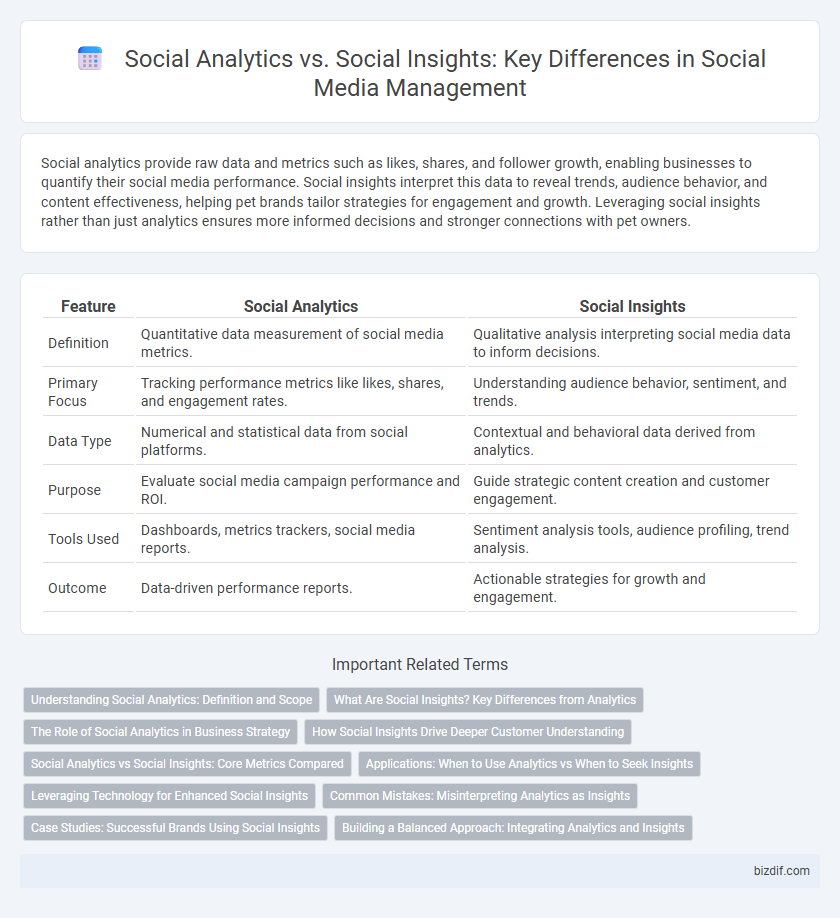Social analytics provide raw data and metrics such as likes, shares, and follower growth, enabling businesses to quantify their social media performance. Social insights interpret this data to reveal trends, audience behavior, and content effectiveness, helping pet brands tailor strategies for engagement and growth. Leveraging social insights rather than just analytics ensures more informed decisions and stronger connections with pet owners.
Table of Comparison
| Feature | Social Analytics | Social Insights |
|---|---|---|
| Definition | Quantitative data measurement of social media metrics. | Qualitative analysis interpreting social media data to inform decisions. |
| Primary Focus | Tracking performance metrics like likes, shares, and engagement rates. | Understanding audience behavior, sentiment, and trends. |
| Data Type | Numerical and statistical data from social platforms. | Contextual and behavioral data derived from analytics. |
| Purpose | Evaluate social media campaign performance and ROI. | Guide strategic content creation and customer engagement. |
| Tools Used | Dashboards, metrics trackers, social media reports. | Sentiment analysis tools, audience profiling, trend analysis. |
| Outcome | Data-driven performance reports. | Actionable strategies for growth and engagement. |
Understanding Social Analytics: Definition and Scope
Social analytics involves collecting and measuring raw data from social media platforms to track metrics like engagement, reach, and impressions. It quantifies user behavior and campaign performance through tools like sentiment analysis, click-through rates, and demographic breakdowns. Social insights go beyond these metrics to interpret patterns and trends, enabling strategic decisions based on user preferences and brand impact.
What Are Social Insights? Key Differences from Analytics
Social insights refer to the deeper understanding and interpretation of social media data, revealing consumer behavior patterns, preferences, and sentiment trends beyond raw metrics. Unlike social analytics, which focuses on quantitative measurements such as engagement rates, reach, and impressions, social insights emphasize qualitative analysis that drives strategic decision-making. These insights enable brands to tailor content, improve customer experience, and optimize campaign performance based on meaningful audience interactions.
The Role of Social Analytics in Business Strategy
Social analytics collects and measures raw data from social media platforms, providing quantitative metrics such as engagement rates, reach, and follower growth that inform business decisions. Social insights interpret this data to uncover patterns, audience behavior, and sentiment trends, allowing companies to tailor marketing strategies and improve customer experiences. Incorporating social analytics into business strategy enables real-time performance tracking and data-driven optimizations, driving higher ROI and competitive advantage.
How Social Insights Drive Deeper Customer Understanding
Social insights go beyond basic social analytics by interpreting data patterns to reveal customer behaviors, preferences, and sentiment trends, enabling tailored marketing strategies. Analyzing engagement metrics alongside qualitative feedback uncovers deeper emotional connections and motivations behind social interactions. Leveraging these insights enhances customer profiling, drives personalized content creation, and improves overall brand resonance on social media platforms.
Social Analytics vs Social Insights: Core Metrics Compared
Social analytics measures quantitative data such as engagement rates, click-throughs, and follower growth to track performance across platforms. Social insights interpret this data to reveal user behavior patterns, preferences, and sentiment, enabling strategic content adjustments. Metrics like reach, impressions, and conversion rates form the foundation for both analytics and insights, but insights go deeper by providing actionable understanding beyond raw numbers.
Applications: When to Use Analytics vs When to Seek Insights
Social analytics quantifies engagement metrics such as likes, shares, and follower growth to measure performance and track trends over time. Social insights interpret the underlying reasons behind these metrics, revealing audience behavior, preferences, and sentiment to inform strategic decisions. Use analytics for monitoring campaign effectiveness and operational reporting, while seeking insights to guide content creation, optimize targeting, and improve customer relationships.
Leveraging Technology for Enhanced Social Insights
Social analytics involves collecting and measuring raw data from social media platforms, such as engagement rates, follower growth, and content reach. Leveraging advanced technology like AI-driven tools and machine learning algorithms enables the transformation of this data into actionable social insights, revealing patterns in audience behavior and sentiment trends. Enhanced social insights empower businesses to optimize content strategies, improve customer engagement, and drive targeted marketing campaigns with greater precision.
Common Mistakes: Misinterpreting Analytics as Insights
Confusing social analytics with social insights often leads to relying solely on quantitative data such as likes, shares, and impressions without understanding the underlying audience behavior or sentiment. Many brands mistake raw metrics for actionable intelligence, resulting in campaigns that fail to resonate or improve engagement effectively. Proper social media management requires interpreting analytics within the context of consumer intent and market trends to generate meaningful insights that drive strategic decisions.
Case Studies: Successful Brands Using Social Insights
Case studies reveal that brands leveraging social insights outperform those relying solely on social analytics by translating raw data into actionable strategies that enhance customer engagement. Companies like Nike and Starbucks use social insights to identify consumer sentiments, tailor campaigns, and predict market trends, leading to increased brand loyalty and revenue growth. This strategic use of social insights demonstrates its effectiveness in driving business decisions beyond basic metrics tracked by social analytics.
Building a Balanced Approach: Integrating Analytics and Insights
Social analytics involve quantitative data such as engagement rates, reach, and follower growth, providing measurable metrics for performance evaluation. Social insights interpret these metrics to uncover audience behavior, preferences, and emerging trends, enabling more strategic decision-making. Integrating social analytics with insights facilitates a balanced approach, optimizing content strategies and enhancing overall social media effectiveness.
social analytics vs social insights Infographic

 bizdif.com
bizdif.com